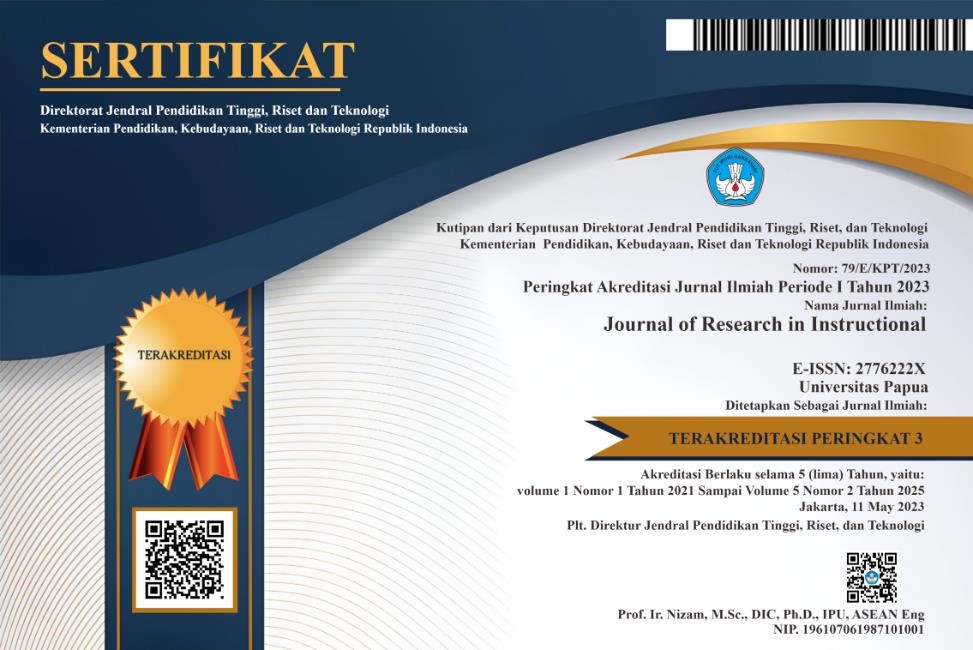Digital literacy level of prospective teacher students in the 4.0 industrial revolution era
DOI:
https://doi.org/10.30862/jri.v4i2.485Keywords:
Age, digital literacy, gender, industrial revolutionAbstract
Digital literacy is an essential competency needed in the Industrial Revolution 4.0 era, driven by rapid technological advancements. This study aims to analyze the level of digital literacy of prospective teacher students in facing the Industrial Revolution 4.0 era, focusing on students’ demographics, namely age, gender and length of study. Survey method was administered in this study, involving 120 prospective teacher students from Universitas Insan Budi Utomo as the respondents. The data were collected through a questionnaire of 1-5 Likert scale, which included questions assessing students' digital literacy levels. The findings of this study portrayed data on students' digital literacy levels according to demographics (gender, age, and length of study). In general, the digital literacy level of Insan Budi Utomo University students is known to be in the “fairly good” category with an average score of 3.14 for the knowledge aspect and 3.20 for the usage aspect. The results of this study are recommended as a reference for designing learning experiences that empower digital literacy, supporting students in becoming more digitally proficient.
References
Ayun, Q. (2021). Analisis Tingkat Literasi Digital dan Keterampilan Kolaborasi Siswa dalam Pembelajaran IPA Kelas VII Secara Daring. Jurnal Didaktika Pendidikan Dasar, 5(1), 271–290. https://doi.org/10.26811/didaktika.v5i1.286
Dang, T. D., Phan, T. T., Vu, T. N. Q., La, T. D., & Pham, V. K. (2024). Digital competence of lecturers and its impact on student learning value in higher education. Heliyon, 10(17). https://doi.org/10.1016/j.heliyon.2024.e37318
Fauzi, N. F., & Usmeldi, U. (2022). Analisis Kemampuan Literasi Digital Siswa SMK. Ranah Research : Journal of Multidisciplinary Research and Development, 4(2), 173–180. https://doi.org/10.38035/rrj.v4i2.466
Imjai, N., Aujirapongpan, S., & Yaacob, Z. (2024). Impact of logical thinking skills and digital literacy on Thailand’s generation Z accounting students’ internship effectiveness: Role of self-learning capability. International Journal of Educational Research Open, 6. https://doi.org/10.1016/j.ijedro.2024.100329
Irhandayaningsih, A. (2020). Pengukuran Literasi Digital Pada Peserta Pembelajaran Daring di Masa Pandemi COVID-19. Anuva: Jurnal Kajian Budaya, Perpustakaan, Dan Informasi, 4(2), 231–240. https://doi.org/10.14710/anuva.4.2.231-240
Kamberidou, I. (2020). “Distinguished” women entrepreneurs in the digital economy and the multitasking whirlpool. Journal of Innovation and Entrepreneurship, 9(3). https://doi.org/10.1186/s13731-020-0114-y
Law N., Woo, D., de la Torre, J., & Wong, G.. (2018). A Global Framework of Reference on Digital Literacy Skills for Indicator 4.4.2 (Information Paper No. 51). UNESCO Institute for Statistics. https://uis.unesco.org/sites/default/files/documents/ip51-global-framework-reference-digital-literacy-skills-2018-en.pdf
Mbandje, D. C., & Loureiro, M. J. (2023). Digital competence and information literacy: clarifying concepts based on a literature review. Educational Media International, 60(3–4), 306–316. https://doi.org/10.1080/09523987.2023.2324584
Moravec, V., Hynek, N., Skare, M., Gavurova, B., & Kubak, M. (2024). Human or machine? The perception of artificial intelligence in journalism, its socio-economic conditions, and technological developments toward the digital future. Technological Forecasting and Social Change, 200. https://doi.org/10.1016/j.techfore.2023.123162
Muhammadiah, M., Wardani, A. N. K., Yuwono, S., Khairunnisa, & Jumriah. (2024). Pemberdayaan Perempuan Dalam Bisnis Online : Peluang Dan Tantangan Di Era Digital. Communnity Development Jpurnal, 5(2), 3924–3931. https://doi.org/10.31004/cdj.v5i2.27663
Muliani, A., Karimah, F. M., Liana, M. A., Pramudita, S. A. E., Riza, M. K., & Indramayu, A. (2021). Pentingnya Peran Literasi Digital bagi Mahasiswa di Era Revolusi Industri 4.0 untuk Kemajuan Indonesia. Journal of Education and Technology, 1(2), 87–92. https://jurnalilmiah.org/journal/index.php/jet/article/view/61
Pambudi, M. A., & Windasari. (2022). Strategi Guru dalam Meningkatkan Literasi Digital pada Siswa. Jurnal Inspirasi Manajemen Pendidikan, 10(3), 636–646. https://ejournal.unesa.ac.id/index.php/inspirasi-manajemen-pendidikan/article/view/48999
Pérez-Escoda, A., García-Ruiz, R., & Aguaded, I. (2019). Dimensions of digital literacy based on five models of development. Cultura y Educacion, 31(2), 232–266. https://doi.org/10.1080/11356405.2019.1603274
Potyrała, K., & Tomczyk, Ł. (2021). Teachers in the lifelong learning process: examples of digital literacy. Journal of Education for Teaching, 47(2), 255–273. https://doi.org/10.1080/02607476.2021.1876499
Raharjo, N. P., & Winarko, B. (2021). Analisis Tingkat Literasi Digital Generasi Milenial Kota Surabaya dalam Menanggulangi Penyebaran Hoaks. Jurnal Komunika: Jurnal Komunikasi, Media Dan Informatika, 10(1), 33–43. https://doi.org/10.31504/komunika.v10i1.3795
Ririen, D., & Daryanes, F. (2022). Analisis Literasi Digital Mahasiswa. Research and Development Journal of Education, 8(1), 210–219. https://doi.org/10.30998/rdje.v8i1.11738
Saikkonen, L., & Kaarakainen, M. T. (2021). Multivariate analysis of teachers’ digital information skills - The importance of available resources. Computers and Education, 168, 104206. https://doi.org/10.1016/j.compedu.2021.104206
Sánchez-Cruzado, C., Santiago Campión, R., & Sánchez-Compaña, M. T. (2021). Teacher digital literacy: The indisputable challenge after covid-19. Sustainability, 13(4), 1–29. https://doi.org/10.3390/su13041858
Tan, Y. (2024). A bibliometric analysis of scholarly literature related to digital literacy in higher education during the pandemic period. Cogent Education, 11(1). https://doi.org/10.1080/2331186X.2024.2341587
Yao, N., & Wang, Q. (2024). Factors influencing pre-service special education teachers’ intention toward AI in education: Digital literacy, teacher self-efficacy, perceived ease of use, and perceived usefulness. Heliyon, 10(14). https://doi.org/10.1016/j.heliyon.2024.e34894
Yustika, G. P., & Iswati, S. (2020). Digital Literacy in Formal Online Education: A Short Review. Dinamika Pendidikan, 15(1), 66–76. https://doi.org/10.15294/dp.v15i1.23779
Zhou, M. (2014). Gender difference in web search perceptions and behavior: Does it vary by task performance? Computers and Education, 78, 174–184. https://doi.org/10.1016/j.compedu.2014.06.005
Downloads
Published
Issue
Section
License
Copyright (c) 2024 Tri Asih Wahyu Hartati, Purwaning Budi Lestari, Nurcholis Istiawan, Ericka Darmawan

This work is licensed under a Creative Commons Attribution-ShareAlike 4.0 International License.






